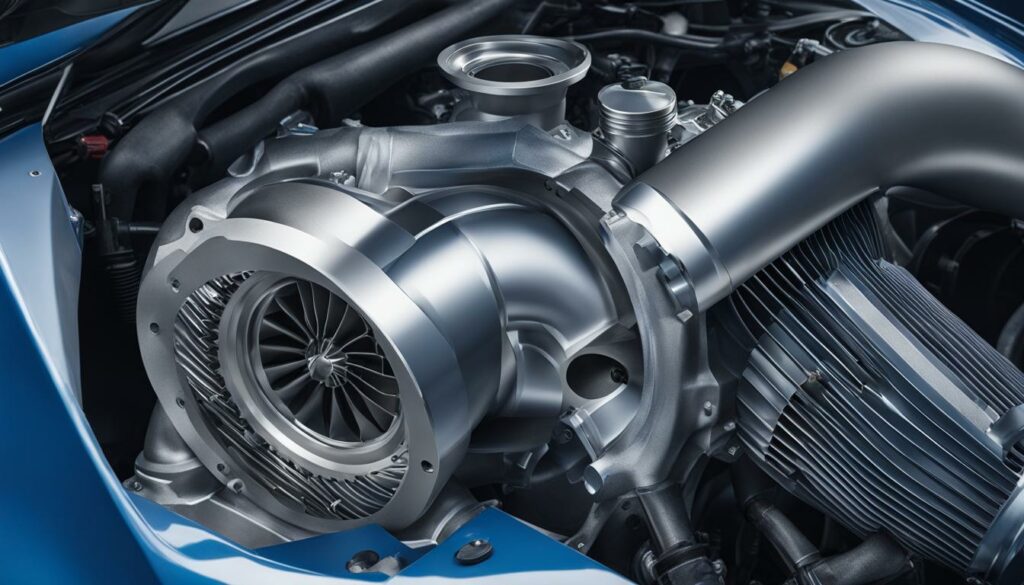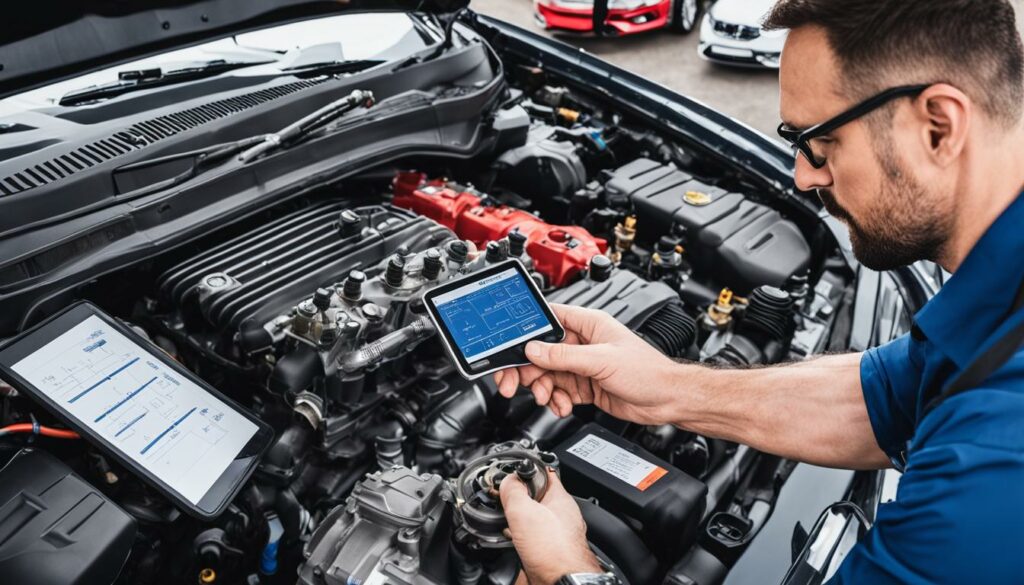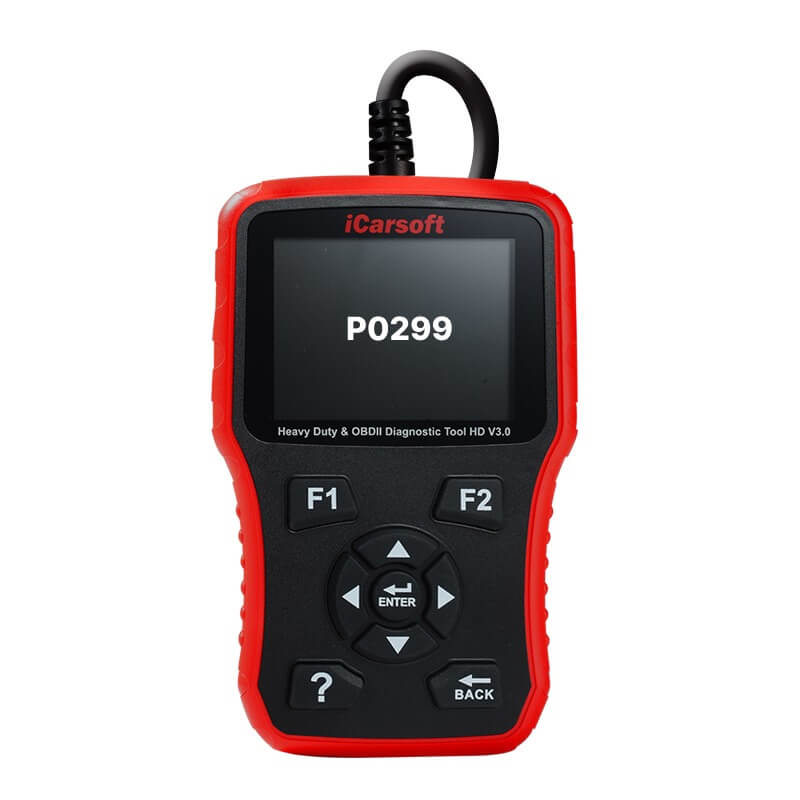P0299 – Turbo Underboost: Understanding the Causes and Solutions
POSTED IN pcodes
If you’re experiencing a decrease in engine performance and power loss, you may be dealing with a P0299 code, also known as the turbo underboost condition. This diagnostic trouble code is triggered when the turbocharger or supercharger in your vehicle is not providing enough boost pressure.
An underboost condition can be concerning as it affects the engine’s performance and can lead to a lack of acceleration. It is essential to address this issue promptly to prevent further damage to your engine and ensure optimal performance.
The P0299 code can have various causes, including a faulty turbocharger or supercharger, low engine oil pressure, a defect in the EGR system, an air or air intake leak or restriction, or a malfunctioning boost pressure sensor. To accurately diagnose the issue, a qualified mechanic will use an OBD-II scanner to read and reset the codes. They will also inspect the turbo/supercharger system visually and check for proper boost pressure readings.
Once the cause has been identified, appropriate repair solutions can be implemented. Depending on the underlying issue, this may involve replacing damaged components such as the turbocharger/supercharger, boost pressure sensor, or EGR valve.
To avoid encountering a P0299 code in the future, it is recommended to stay on top of regular vehicle maintenance. This includes monitoring the turbocharger/supercharger system, inspecting wiring and connectors for any issues, and ensuring regular oil and filter changes.
Buy tested tuning file for Adblue / EGR / DPF / Adblue off now!
Key Takeaways:
- A P0299 code indicates an underboost condition in the turbocharger or supercharger system of your vehicle.
- Possible causes include a defective turbocharger or supercharger, low engine oil pressure, EGR system defects, air or air intake leaks or restrictions, and a faulty boost pressure sensor.
- Accurate diagnosis involves using an OBD-II scanner, performing a visual inspection, and checking for proper boost pressure readings.
- Repair solutions may include replacing damaged components or parts such as the turbocharger/supercharger, boost pressure sensor, or EGR valve.
- To prevent the P0299 code, regular maintenance of the turbocharger/supercharger system, wiring and connector checks, and regular oil and filter changes are crucial.
Symptoms of P0299 – Turbo Underboost
When your vehicle triggers a P0299 code, there are several symptoms to be aware of that may indicate an underboost condition in the turbocharger or supercharger system.
- Illuminated check engine light: One of the most common symptoms is the illumination of the check engine light on your dashboard. This is the system’s way of alerting you to a potential issue.
- Lack of acceleration: Another indicator of an underboost condition is a noticeable lack of acceleration. You may notice that your vehicle is slow to respond when you step on the gas pedal.
- Engine power loss: A decrease in engine power is a common symptom of a P0299 code. You may experience a significant reduction in power when trying to accelerate or climb hills.
- Mechanical noise: Additionally, you may hear unusual mechanical noises coming from the engine, such as hissing, whining, or rattling. These noises can be a result of decreased boost pressure.
It is important to address these symptoms promptly to prevent further damage to your engine and ensure proper vehicle operation. Ignoring these signs can lead to decreased performance and potential engine issues.

Diagnostic Steps for P0299 – Turbo Underboost
In order to diagnose a P0299 code indicating an underboost condition in the turbocharger or supercharger system, there are specific steps that should be followed. By following these diagnostic steps, a qualified mechanic can accurately identify the cause of the code and provide appropriate repair solutions.
1. Use an OBD-II Scanner to Read Codes and Retrieve Freeze-Frame Data
Begin the diagnostic process by connecting an OBD-II scanner to the vehicle’s diagnostic port. The scanner will read the codes and retrieve freeze-frame data, which provides information on when and how the P0299 code occurred. This data is crucial in understanding the context and conditions under which the underboost condition was triggered.
2. Perform a Visual Inspection of the Turbo/Supercharger System
Next, conduct a thorough visual inspection of the turbo/supercharger system, EGR system, and intake system. Look for any visual signs of damage, leaks, or loose connections. Pay close attention to the turbocharger, examining it for any physical abnormalities or signs of failure. Inspect the intake system for any leaks or restrictions that may be affecting boost pressure.
3. Check Boost Pressure Readings
Utilize the scan tools to check the boost pressure readings during different operating conditions. Compare these readings against the manufacturer’s specifications to determine if the boost pressure is within the accepted range. Abnormally low boost pressure readings may indicate the presence of an underboost condition.
4. Inspect Mechanical Systems
Inspect the turbocharger/supercharger and other mechanical systems for any faults or issues. Check for proper operation of the turbocharger actuator or wastegate, as well as any signs of wear or damage to the turbocharger components. Additionally, inspect the oil pressure to ensure it is within the recommended range, as low oil pressure can affect turbocharger performance.
5. Identify any Leaks or Restrictions in the Intake System
As part of the diagnostic process, it is important to identify any leaks or restrictions in the intake system. Leaks can result in a loss of boost pressure, while restrictions can impede the flow of air into the engine. Inspect the intercooler, hoses, clamps, and connections for any signs of leaks, cracks, or loose fittings. Addressing any leaks or restrictions is crucial for resolving the underboost condition.
By following these diagnostic steps, a qualified mechanic can accurately identify the cause of the P0299 code and determine the appropriate repair solutions. The thorough use of an OBD-II scanner, visual inspection, boost pressure readings, and inspection of mechanical systems and intake system will provide valuable insights into the underboost condition and guide the repair process.

Common Causes of P0299 – Turbo Underboost
The P0299 code, indicating an underboost condition in the turbocharger or supercharger system, can be attributed to several common causes. It is essential to identify and address these causes to resolve the issue effectively.
Boost Leak
A common cause of the P0299 code is a boost leak, where pressurized air escapes from the charge system after the turbocharger or supercharger. This leakage disrupts the target boost level, leading to an underboost condition.
Faulty Diverter Valve
Another common cause is a faulty diverter valve. This valve is responsible for diverting pressurized air and ensuring the desired boost level is achieved. If the diverter valve malfunctions, it can result in pressurized air leakage and contribute to the underboost condition.
Boost Pressure Regulation Valve Failure
A failed boost pressure regulation valve can also cause the P0299 code. This valve is responsible for controlling the opening of the wastegate on the turbocharger, which affects boost pressure. If the valve fails, it can lead to an underboost condition.
Turbocharger or Supercharger Failure
Turbocharger or supercharger failure is another potential cause of the P0299 code. If the turbocharger or supercharger malfunctions or fails, it can significantly impact the boost pressure and result in an underboost condition.
Faulty Boost Pressure Sensor
The boost pressure sensor plays a vital role in measuring and relaying the boost pressure information to the engine control unit. A faulty boost pressure sensor can give inaccurate readings or fail to detect the actual boost pressure, leading to an underboost condition.
| Common Causes | Description |
|---|---|
| Boost Leak | Pressurized air escaping from the charge system after the turbocharger or supercharger |
| Faulty Diverter Valve | Diverter valve malfunction causing pressurized air leakage |
| Boost Pressure Regulation Valve Failure | Failure of the valve controlling the wastegate opening on the turbocharger |
| Turbocharger or Supercharger Failure | Malfunction or failure of the turbocharger or supercharger |
| Faulty Boost Pressure Sensor | Malfunction or inaccurate readings from the boost pressure sensor |
Identifying the specific cause of the P0299 code is crucial for accurate diagnosis and effective repair. Proper diagnostic steps and troubleshooting procedures can help pinpoint the underlying issue and facilitate the appropriate repair solution.
Repair Solutions for P0299 – Turbo Underboost
Once a P0299 code has been diagnosed, it is crucial to take appropriate repair solutions that address the underlying cause of the underboost condition. Depending on the specific issue, there are several repair options that can be implemented.
If the fault code appears sporadically or intermittently, you can try clearing the code using an OBD-II scanner and then take the car for a test drive to see if the code returns. However, if the code persists, it is essential to address the root cause of the problem.
Here are some common repair solutions for the P0299 code:
- Fixing boost leaks in the intake air system: Boost leaks can result in a loss of pressure, leading to an underboost condition. Thoroughly inspect the intake air system for any leaks and repair them accordingly.
- Replacing the air filter: A clogged or dirty air filter can restrict the airflow into the engine, affecting the performance of the turbocharger or supercharger. Regularly replacing the air filter can help maintain proper air intake.
- Addressing low engine oil pressure: Low engine oil pressure can impact the lubrication of the turbocharger or supercharger, leading to performance issues. Check the oil pressure and address any underlying issues, such as oil leaks or faulty oil pressure sensors.
- Repairing or replacing the boost pressure sensor: A malfunctioning boost pressure sensor can provide inaccurate readings to the engine control unit, resulting in an underboost condition. If necessary, repair or replace the sensor to ensure accurate boost pressure monitoring.
- Replacing the EGR (Exhaust Gas Recirculation) valve: A faulty EGR valve can disrupt the flow of exhaust gases, affecting the overall performance of the turbocharger or supercharger. If the EGR valve is causing the underboost condition, replacing it may be necessary.
- Ultimately replacing the turbocharger/supercharger: If all other repair solutions are unsuccessful or if the turbocharger or supercharger is severely damaged, replacing the entire unit may be the most effective solution. Consult with a qualified mechanic for professional advice.
It is crucial to note that proper diagnosis by a qualified mechanic is essential before implementing any repair solutions. They can accurately assess the cause of the underboost condition and recommend the most appropriate repairs for your specific vehicle.
Tips to Avoid a P0299 Code
To avoid encountering a P0299 code, it is important to prioritize regular maintenance of your vehicle’s turbocharger/supercharger system. By monitoring and maintaining these components, you can ensure they are functioning properly and reduce the likelihood of experiencing an underboost condition.
Additionally, regular vehicle maintenance plays a crucial role in preventing the occurrence of P0299 codes. It is recommended to service your car according to the manufacturer’s recommendations and schedule. Regularly inspecting the wiring and connectors for any issues can help identify and address potential problems before they lead to underboost conditions.
Another essential aspect of vehicle maintenance that can help you avoid P0299 codes is regular oil and filter changes. Clean oil and filters are vital for maintaining optimal engine performance and preventing any restrictions in the turbocharger/supercharger system.
Remember, proactive maintenance and care go a long way in preventing engine performance issues and ensuring a smooth driving experience.
Here are some tips to avoid a P0299 code:
- Monitor and maintain your turbocharger/supercharger system.
- Follow the manufacturer’s recommended vehicle maintenance schedule.
- Regularly inspect the wiring and connectors for any issues.
- Change your oil and filters at the recommended intervals.
| Maintenance Tips |
|---|
| Regularly monitor and maintain your turbocharger/supercharger system |
| Follow the manufacturer’s recommended vehicle maintenance schedule |
| Inspect wiring and connectors for any issues |
| Change oil and filters at recommended intervals |
Conclusion
In conclusion, the P0299 code indicates an underboost condition in the turbocharger or supercharger system of your vehicle. To accurately identify the cause of the code, it is important to follow proper diagnostic steps. Using an OBD-II scanner and performing a visual inspection can help pinpoint the underlying issue.
Common causes of the P0299 code include boost leaks, faulty diverter valves, boost pressure regulation valve failures, turbocharger or supercharger failures, and faulty boost pressure sensors. The specific cause of the underboost condition will determine the appropriate repair solution. This may involve fixing boost leaks, replacing damaged components, or performing other necessary repairs.
To prevent the occurrence of the P0299 code, regular vehicle maintenance is crucial. Monitor the turbocharger/supercharger system, check wiring and connectors for any issues, and ensure regular oil and filter changes. By addressing this code promptly and maintaining your vehicle properly, you can ensure optimal performance and avoid future underboost conditions.
FAQ
What does the P0299 code mean?
The P0299 code indicates an underboost condition with the turbocharger or supercharger in a vehicle. It is triggered when the Engine Control Unit (ECU) detects excessively low output of boost pressure.
What are the symptoms of a P0299 code?
Common symptoms of a P0299 code include the illumination of the check engine light, a lack of acceleration or engine power, and the presence of mechanical noises coming from the engine.
What are the diagnostic steps for a P0299 code?
The diagnostic steps for a P0299 code involve using an OBD-II scanner to read and reset the codes, performing a visual inspection of the turbo/supercharger system and related components, and checking for proper boost pressure readings.
What are the common causes of a P0299 code?
Common causes of a P0299 code include boost leaks, faulty diverter valves, boost pressure regulation valve failures, turbocharger or supercharger failures, and faulty boost pressure sensors.
What are the repair solutions for a P0299 code?
Repair solutions for a P0299 code may involve fixing any boost leaks in the intake air system, replacing the air filter, addressing low engine oil pressure issues, repairing or replacing the boost pressure sensor, replacing the EGR valve, or ultimately replacing the turbocharger/supercharger.
How can I avoid a P0299 code?
To avoid a P0299 code, regular maintenance of the turbocharger/supercharger system is recommended. This includes monitoring and maintaining the components to ensure they are functioning properly. Regular vehicle maintenance, such as servicing the car and inspecting wiring and connectors, can also help prevent underboost conditions.


